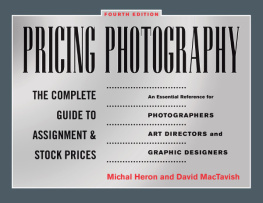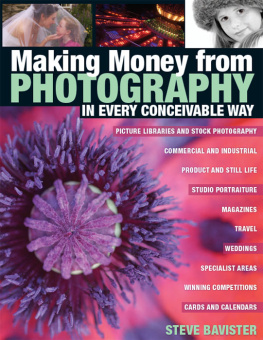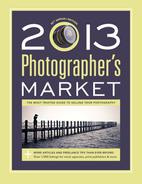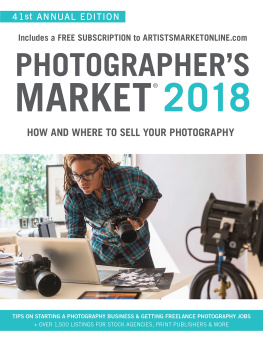CONTENTS
HOW TO USE THIS EBOOK
Select one of the chapters from the and you will be taken straight to that chapter.
Look out for linked text (which is blue) throughout the ebook that you can select to help you navigate between related sections.
You can double tap images to increase their size. To return to the original view, just tap the cross in the top left-hand corner of the screen.
PREFACE
M y initial response was to decline the invitation to write a book on producing stock photography. How could I write a volume that would provide everything you always wanted to know but were afraid to ask without bringing forward my own biases and prejudices? I assumed the vast majority of readers would be looking for a how to get wealthy type of tome, while my understanding of the industry suggests the opposite is closer to reality.
Speaking with several of my peers, I was reminded that I have forged a comfortable living doing what I love. For 30 years I have produced stock photography as a sole source of income. Being a stock photographer was not an occupation or vocation; this was a passion that supported a very enviable lifestyle of traveling the planet doing what I love to domaking photographs and getting well paid to do so.
It was also necessary to look inward and do some serious soul-searching. I worked in an era many refer to as the glory years, a time when monthly income was measured in tens of thousands of dollars per month. Anyone that had a good library of images also had a few in that collection that earned significant accrued royaltiesinto the hundreds of thousands of dollars per imageover years of licensing history.
Wildlife portrait
An image of the common loon goes beyond a family portrait. It suggests any number of taglines that convey family, success and nourishment, as examples.
Potential taglines: Strength in family; Getting the job done; A winning combination; Making the commitment; Success in teamwork.
Exploring the industry
Stock photography has typically been for the intrepid and itinerant. Whether on the road for extended periods of time or in the confines of a warm studio, the stock photographer is very much left to their own devices to learn the nuances of the industry.
Put in context, the average license fee was in the neighborhood of $450 per usage. We could reliably develop an annual revenue budget by factoring $15 per month for each image on file. A monthly sales statement would typically show several sales worth more than $1,000, and it was always fun to see which image might have been licensed for more than $5,000. My record individual sale was a trade exclusive one-year license worth $32,000.
The so-called glory days came to a crashing halt during the 2008 global financial crisis.
The economic meltdown continued well into 2012, with the stock photo industry going through a massive reorganization by way of takeovers, restructuring, and mergers. What evolved was a changed industry with license fees and photographer royalties having been completely redesigned. Gone were the days of stock photographers enjoying income brackets comparable to the best lawyers and doctors in the free world.
Would this be where my bias would reveal its ugly self? Would I become one of those writing of the good old days? In short, was I more afraid of becoming one of the grumpy old men dining on stewed prunes and longing for the past than of sharing accumulated knowledge?
Upon reflection, I also recognized there were topics that have not changed with time. These would be the topics I could bring forward and share with the reader in this book. Image style has changed, but without question, basic concepts have remained constant over time. The dollar value of the individual license may have decreased since 2008, but advertising copywriters still use the same buzzwords as they always have. Consequently, I discerned, this book would concentrate its efforts on how to make working photos. I would leave the task of maximizing the income potential of those images with the readermost likely a far younger and much more cyber-savvy practitioner than myself.
One of the most difficult challenges the novice stock photographer must face is learning how to make a working picture. Regardless of ones specialty, in order to create bestselling images one must learn to transcend their efforts from snapshots to well-executed images that have clarity and a timeless simplicity. This is where I hope to bring the experience of working in those socalled heydays to my modern contemporaries.
I see this work as a passing of the torch, if you will. I may reminisce on occasion, but I hope I have earned that right. I believe that the taglines and buzzwords that worked in the past will also work in the future. The definition of the buzzword success is the same regardless of decade or language. The contemporary stock photographers task is to interpret these buzzwords with a fresh perspective. If just one reader grasps and understands this concept, then I will consider this book to be a success.
That being said, I wish you every level of success. It is not as important to work hard than it is to work smart, for the smarter you work, the luckier you will become.
Contemporary success
The female role in business was at one time primarily restricted to a secretarial or clerical support role. Thankfully this has changed, and the workplace continues to become more equal in terms of gender. As visual communicators, we must be tuned-in to the future: success is success regardless of era, the only thing that will change is how we visually portray that message.
Conceptual success
More often than not, success in stock photography is achieved by making images that are suggestive of a theme rather than a literal interpretation.
THE NEW BUSINESS: INTRODUCTION
T he question often debated among seasoned stock photographers is whether the stock photographer still has the capacity to earn a livelihood from his or her craft. In a nutshell, it would appear that if old business models are utilizedby old, think pre-2008the chances of success are quite minimal, at best.
The savvy and intrepid freelance stock photographers working today need to have solid, cutting-edge business practices coupled with a creative vision to foresee and execute what will be in demand in 18 months time, not what is in vogue today.





















